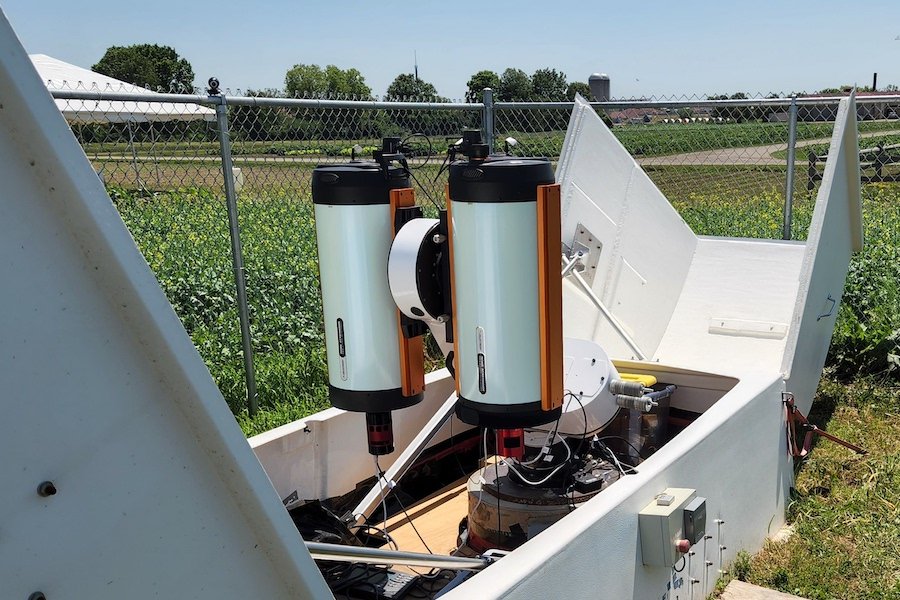Kelly receives $1 million grant to build superfast ‘TURBO’ telescopes

Technology can scan the sky more than 10 times faster than existing telescopes
MINNEAPOLIS / ST. PAUL (10/06/2022)—A team led by School of Physics and Astronomy Assistant Professor, Patrick Kelly, is constructing two sets of telescopes that will open a new window into the collisions of neutron stars and black holes. is constructing two sets of extremely fast telescopes that will enable more detailed studying of gravitational waves and light created by colliding black holes and neutron stars. The telescopes will be able to scan the sky more than 10 times faster than the average telescope.
The three-year Total-Coverage Ultra-Fast Response to Binary-Mergers Observatory (TURBO) project is funded by a $1 million grant from the National Science Foundation. Once they’re built, the telescopes will be placed at two sites: the Magdalena Ridge Observatory in New Mexico and the Skinakas Observatory on Psiloritis, the tallest mountain peak in Crete, Greece.
“With its novel fast response and two vantage points on the sky, TURBO will open up a new frontier for studying objects in the sky that change in brightness,” said Patrick Kelly, the lead project investigator and an assistant professor in the University of Minnesota School of Physics and Astronomy.
Both gravitational waves—which can be thought of as “ripples” in spacetime—and light provide different information about cataclysmic events. The combination of gravitational waves and light emitted from colliding black holes and neutron stars can help researchers understand how gold and other heavy elements may be produced, and it can be used to calculate the expansion rate of the Universe.
Gravitational-wave observatories are only able to approximately determine where black hole and neutron star mergers occur in the sky. With the TURBO telescopes, scientists will have a new avenue for finding the light emitted by mergers, which has only ever been identified for one merger in 2017.
While current telescopes might take between several minutes to an hour to get images of the area where a merger has occurred, the TURBO telescopes can get an image of the same area in about two seconds.
The images are also high resolution, made possible by minuscule camera technology developed for use in smartphones. At each observatory site, there will actually be 16 total telescopes—eight mounts each with two scopes—and each scope will be able to capture 61 million pixels.
The U of M team also hope the telescopes will allow them to discover supernova explosions within a minute of them exploding—or right when the light reaches the Earth—a feat that hasn’t been done before.
“Supernovas have been observed, but there’s a lag,” Kelly explained. “If we can find them right away, we can immediately start observing them with satellites and other telescopes, including Minnesota’s telescope on Mt. Lemmon in Arizona.”
While the research team spans universities across the country, most of the prototype building has been done by University of Minnesota students.
“This project provides a really good opportunity to work with top-of-the-line hardware, get access to real-world data, and be able to apply all of the theoretical things I’ve learned in classes,” said Matthew Tran, a University of Minnesota undergraduate student studying computer science. “It provides an interesting opportunity to learn things in an interdisciplinary way. You can be good at writing software, but you also need the skills to interface with other fields like astronomy, so that’s really useful for me as a computer science major.”
“What I’m most excited for is to be able to find these neutron star mergers quickly,” said Daniel Warshofsky, a Ph.D. student in the University of Minnesota School of Physics and Astronomy and a recipient of the Edward P. Ney Graduate Student Fellowship in Astrophysics. “A lot of times people think of space and astronomy as very big things that happen over long periods of time, but the things that we’re looking for happen on the scale of seconds to minutes to hours, so it’s really important to catch this stuff early."
In addition to Kelly, Tran, and Warshofsky, the research team includes University of Minnesota Twin Cities School of Physics and Astronomy faculty members Michael Coughlin, Terry Jones, Robert Gehrz, Lucy Fortson, Claudia Scarlata, and Vuk Mandic; postdoctoral scholar Robert Strausbaugh; alumnus Thomas Procter; undergraduate student Cole Panzer; Ph.D. student Ann Isaacs; University of Minnesota Twin Cities Department of Computer Science and Engineering undergraduate student Sam Benscoter; Carleton College undergraduate student Youssef Haddad; and University of Minnesota Duluth undergraduate student Carter Inman.